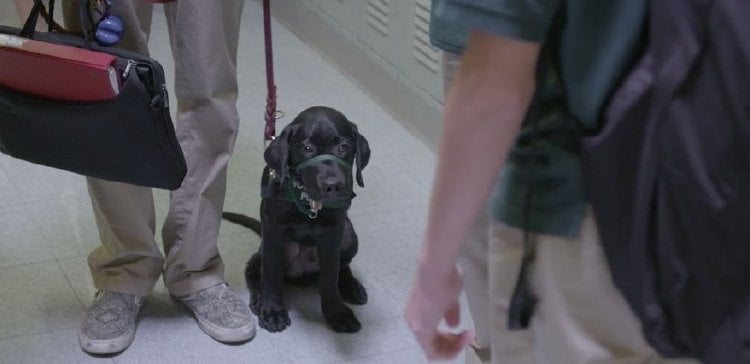Pick of the Litter

The non-profit organization Guide Dogs for the Blind was established in 1942 to help the returning GIs blinded in the war. The success of that program, if you have ever seen a guide dog in action, is obvious. Documentary filmmakers Don Hardy Jr. and Dana Nachman introduce us to five Labrador pups, three brothers and two sisters, selected to try out for the program and be the “Pick of the Litter.”
Laura's Review: B
Every year, 800 puppies are born at Guide Dogs for the Blind. Only 300 of them will make it all the way through guide dog training and graduate with a partnered person. They are the "Pick of the Litter." Codirected by "Batkid Begins'" cinematographer Don Hardy Jr. and its writer/director Dana Nachman, "Pick of the Litter" is a fascinating look into all the hard work and heartbreak that goes into channeling a puppy into a career as a guide dog. This soup to nuts documentary begins with the birth of a litter of five retrievers, all given names beginning with the letter 'P,' and ends with the graduation of the two who eventually succeed. The three siblings who 'career change out' all take their own, separate paths. Along the way we see how Guide Dogs' personnel does the initial training before handing off puppies to 'raisers,' volunteers who keep the dogs while training them in such things as heeling. The dogs are discouraged from distractions such as other dogs. In one of the most non-intuitive bits of training, a bit of decision making only guide dogs are trained for, the dogs must know when to disobey an order to protect their owner, keeping, for example, a safety barrier from a blind person and moving vehicle. The raisers bring in the dogs for several evaluations before final testing. Some are careered out, like Potomac, a dog with so much effusive energy he becomes a regular pet. Some are handed off to 'fixers' to correct behaviors such as nipping. A disabled vet takes Patriot from his high school aged raiser, but even he cannot get the dog to pass the stringent tests. Happily, Patriot becomes his own emotional therapy dog. Primrose is a bit excitable and becomes a breeder for future Guide Dogs, a designation her raisers are proud of. Phil's raiser is taken aback when the dog is reassigned, and while he improves with the couple who take over his training, he still struggles in the final testing. But Phil eventually aces his tests, as does Poppet. The blind man and woman we meet early on are overwhelmed meeting their new dogs, both emotional over pairings which look destined for success. All the raisers, even Phil's initial one, are present at their graduation. Nachman admits in the movie's press notes that she was partially motivated by the idea of spending lots of time with puppies and the film does feature an awful lot of cuteness. But championing the work of this organization is the film's higher goal and while it succeeds, the documentary favors emotion over information. We do get a solid sense of how the process works, but it would have been interesting to hear why this particular breed is so often used and how, specifically, dogs are trained to do (or not do) certain things. Also, a cause dear to my heart, the adoption of senior guide dogs whose owners are unable to keep them after their retirement, is never mentioned. Still, "Pick of the Litter" shines a light on an organization that deserves support and it entertains while it does so. The dog is man's best friend in more ways than companionship. Grade:
Robin's Review: B-
About all that I knew about the GDB program, before seeing this well-made process documentary, was that there existed a Guide Dogs for the Blind program. That was about it. Filmmakers Hardy and Nachman fix that and introduce us to that program with the five pups – Patriot, Phil, Potomac, Primrose and Poppet – at birth. These little guys have been selected for the program but, of the 1000 dogs a year that enter, only 300 make it through to being paired with a blind person. The pups, after being whelped, are given to selected families to teach them the basics of obedience and training. After they pass the first test, of good manners, the successful pups move on to the next stage of training, where they are further vetted. Only the young dogs that pass the five tests – obedience, guide work, buildings and escalators, traffic and sidewalkless streets – are moved on to the last stage before graduation, working with the blind person they will be paired with. The filmmakers follow each of the five puppies through all of the stages of training, and their successes and failures, as they are carefully evaluated to meet all the stringent requirements for GDB. (I do not want to give anything away about who makes it and who does not.) This is a wonderfully entertaining process film that invests the viewer in the lives our five little potential heroes. The puppy stuff is great and you root for them all. But, it is the fine work that the dedicated people, many of them volunteers, go through to make sure that their dogs are, indeed, the pick of the litter.

